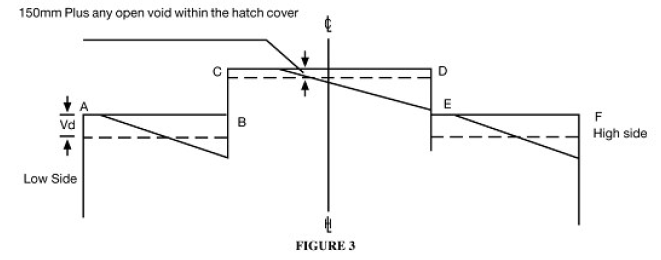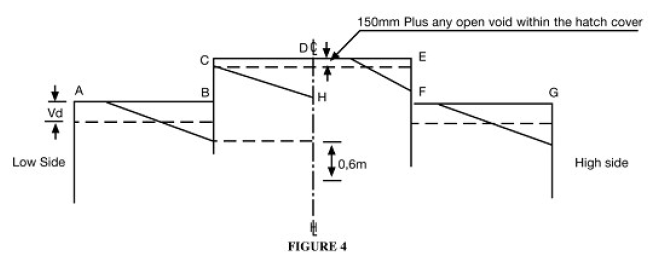


Merchant Shipping Act, 1951 (Act No. 57 of 1951)SchedulesSecond ScheduleProtocol of 1978 Relating to the International Convention for the Safety of Life at Sea, 1974AnnexChapter VI : Carriage of GrainPart B — Calculation of Assumed Heeling MomentsSection II — Assumed Volumetric Heeling Moment of a Filled Compartment |
(A) GENERAL
| (a) | The pattern of grain surface movement relates to a transverse section across the portion of the compartment being considered and the resultant heeling moment should be multiplied by the length to obtain the total moment for that portion. |
| (b) | The assumed transverse heeling moment due to grain shifting is a consequence of final changes of shape and position of voids after grain has moved from the high side to the low side. |
| (c) | The resulting grain surface after shifting shall be assumed to be at 15 degrees to the horizontal. |
| (d) | In calculating the maximum void area that can be formed against a longitudinal structural member, the effects of any horizontal surfaces, e.g. flanges or face bars, shall be ignored. |
| (e) | The total areas of the initial and final voids shall be equal. |
| (f) | A discontinuous longitudinal division shall be considered effective over its full length. |
(B) ASSUMPTIONS
In the following paragraphs it is assumed that the total heeling moment for a compartment is obtained by adding the results of separate considerations of the following portions:
| (a) | Before and abaft hatchways: |
| (i) | If a compartment has two or more main hatchways through which loading may take place the depth of the underdeck void for the portion(s) between such hatchways shall be determined using the fore and aft distance to the midpoint between the hatchways. |
| (ii) | After the assumed shift of grain the final void pattern shall be as shown in Figure 2 below: |

Notes on Figure 2.
| (1) | If the maximum void area which can be formed against the girder at B is less than the initial area of the void under AB, i.e. AB x Vd, the excess area shall be assumed to transfer to the final void on the high side. |
| (2) | If the longitudinal division at C is one which has been provided in accordance with subparagraph (b) (ii) of Regulation 5 of this Chapter it shall extend to at least 0,6 metre below D or E whichever gives the greater depth. |
(b) In and abreast hatchways:
After the assumed shift of grain the final void pattern shall be as shown in the following Figure 3 or Figure 4.

Notes on Figure 3.
| (1) | AB.—Any area in excess of that which can be formed against the girder at B shall transfer to the final void area in the hatchway. |
| (2) | CD.—Any area in excess of that which can be formed against the girder at E shall transfer to the final void area on the high side. |

Notes on Figure 4.
| (1) | If the centreline division is one which has been provided in accordance with subparagraph (b) (ii) of Regulation 5 of this Chapter it shall extend to at least 0,6 metre below H or J whichever gives the greater depth. |
| (2) | The excess void area from AB shall transfer to the low side half of the hatchway in which two separate final void areas will be formed viz. one against the centreline division and the other against the hatchside coaming and girder on the high side. |
| (3) | If a bagged saucer or bulk bundle is formed in a hatchway it shall be assumed, for the purpose of calculating transverse heeling moment, that such a device is at least equivalent to the centreline division. |
(C) COMPARTMENTS LOADED IN COMBINATION
The following paragraphs describe the pattern of void behaviour which shall be assumed when compartments are loaded in combination:
| (a) | Without effective centreline divisions: |
| (i) | Under the upper deck—as for the single deck arrangement described in Section II (B) of this Part. |
| (ii) | Under the second deck—the area of void available for transfer from the low side, i.e. original void area less area against the hatchside girder, shall be assumed to transfer as follows: |
One-half to the upper deck hatchway and one-quarter each to the high side under the upper and second deck.
| (iii) | Under the third and lower decks—the void areas available for transfer from the low side of each of these decks shall be assumed to transfer in equal quantities to all the voids under the decks on the high side and the void in the upper deck hatchway. |
| (b) | With effective centreline divisions which extend into the upper deck hatchway: |
| (i) | At all deck levels abreast the division the void areas available for transfer from the low side shall be assumed to transfer to the void under the low side half of the upper deck hatchway. |
| (ii) | At the deck level immediately below the bottom of the division the void area available for transfer from the low side shall be assumed to transfer as follows: |
One-half to the void under the low side half of the upper deck hatchway and the remainder in equal quantities to the voids under the decks on the high side.
| (iii) | At deck levels lower than those described in subparagraphs (i) and (ii) of this paragraph the void area available for transfer from the low side of each of those decks shall be assumed to transfer in equal quantities to the voids in each of the two halves of the upper deck hatchway on each side of the division and the voids under the decks on the high side. |
(c) With effective centreline divisions which do not extend into the upper deck hatchway:
Since no horizontal transfer of voids may be assumed to take place at the same deck level as the division the void area available for transfer from the low side at this level shall be assumed to transfer above the division to voids on the high sides in accordance with the principles of paragraphs (a) and (b) above.